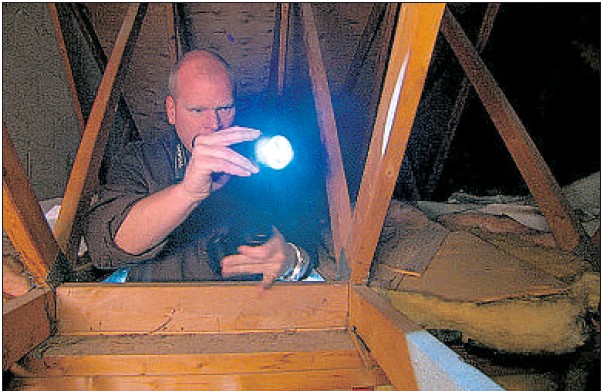PROBLEMS: Insufficient insulation, ventilation are all too common
MIKE HOLMES
Province

Mike Holmes says to always check the attic, even if a voice inside your head keeps saying “Don’t go in there!” — SUBMITTED PHOTO
What’s in your attic? Usually when I have to stick my head up through an attic hatch to inspect the space, I get a sense of dread. It’s like I’m in a horror movie and there are monsters in the attic. It’s easy to see warning signs of attic problems without going up there — ice dams, roof damage, water dripping from soffit vents, ceiling stains. But just like the guy in the horror movie, I still have to look inside, even though a voice inside my head is saying, “Don’t go in there!”
What’s in your attic? If I looked in there, I hope I’d find insulation. I hope there’d be enough vents. I hope I wouldn’t find: mould, wet insulation, dirty insulation, vermiculite insulation and/or no insulation, animal or bird droppings, blocked or non-existent vents, or kitchen and bathroom exhaust fans venting into the attic. But believe me, I’ve found them all.
Of the many problems you can find in an attic, most are caused by inadequate insulation, insufficient ventilation and air movement — and the last one is the most damaging.
You have to have enough insulation in your attic. You really can’t have too much unless you’ve put in so much that you are actually touching the underside of the roof or blocking the venting. Insulation is necessary to prevent or slow the transfer of heat from one area of the house to another — like from your living room into your attic and out the roof.
You can use a number of different materials like fibreglass, blown-in cellulose, spray foam, rigid foam, batt insulation even recycled blue jeans. Insulation will help reduce heat loss, and improve the energy efficiency of your home.
Your attic also must be ventilated. If it isn’t, any moisture or water vapour that is present in the space can lead to serious problems, like mould or rot. A lot of moisture from everyday living — from showers, laundry, doing the dishes — will rise into the attic along with the warm air it’s carried by. Once there, condensation will occur.
Condensation can soak your attic insulation, destroying its effectiveness. In winter, the warm, moist air sneaks into the attic, where it’s cold or freezing, and frost forms on the underside of the roof. Sometimes homeowners have what they think is a leak in the roof, because there’s moisture or staining on the ceiling of the room below. There may be mould on the underside of the roof sheathing, rafters, or trusses. The plywood sheathing may rot out altogether in time.
You definitely need roof vents — either soffit vents (make sure they aren’t covered by insulation), a ridge vent, or a turbo vent. All vents should have screens to prevent wildlife from getting inside. Check with a professional roofer for how many vents you need, given your roof’s size.
Roof vents move hundreds of cubic feet of hot air and moisture out of the attic.
But, if you do have condensation problems in the attic, increasing ventilation by adding more vents might not be the answer. Too much venting will suck even more warm, moist air out of your living space and into your attic where not only are you wasting heat, you are creating more condensation.
The most important thing to do to prevent attic problems is to properly seal the attic, and prevent air movement between the warm and cold zones of your house. If you prevent the warm moist air from flowing into the attic where it will inevitably condense, you likely won’t see problems with moisture and mould.
Make sure your attic has plenty of insulation and good ventilation, but most important try to minimize or eliminate air movement. You can sometimes see evidence of air movement if the insulation is dirty in specific areas. Check the vapour barrier for leaks and seal them. Seal around the attic hatch. You can often find leaks around penetrations like plumbing stacks and light fixtures.
Catch Mike in his brand new series, Holmes Inspection airing Thursdays at 8 p.m. on HGTV. For more information visit www.hgtv.ca

